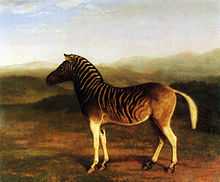Jacques-Laurent Agasse


Jacques-Laurent Agasse (April 24, 1767 – December 27, 1849) was an animal and landscape painter from Switzerland.
Born at Geneva, Agasse studied in the public art school of that city. Before he turned twenty he went to Paris to study in veterinary school to make himself fully acquainted with the anatomy of horses and other animals. He seems to have subsequently returned to Switzerland. The Tübinger Morgenblatt (1808, p. 876) says that "Agasse, the celebrated animal painter, now in England, owed his fortune to an accident. About eight years ago, he being then in Switzerland, a rich Englishman asked him to paint his favourite dog which had died. The Englishman was so pleased with his work that he took the painter to England with him."
Nagler says that he was one of the most celebrated animal painters at the end of the 18th and the beginning of the 19th century. In Meusel's Neue Miscellaneen (viii. 1052 et seq.), he compares Agasse and Wouvermans, wholly in favour of the former. In that partial article much is said of his extreme devotion to art, of his marvelous knowledge of anatomy, of his special fondness for the English racehorses, and his excellence in depicting them. He appears first in the Academy catalogues in 1801 as the exhibitor of the 'Portrait of a Horse', and continued to exhibit more or less until 1845 (contradicting Nagler's statement that he died "about" 1806).
In the catalogues his name is given as J.L. Agasse or Agassé. The number of times Agassé changed his address confirms Redgrave's assertion that "he lived poor and died poor". The writer of the panegyric already quoted says, however, that he did not work for money, but that he was urged forward by the resistless force of natural genius.
Gallery
-

Landing at Westminster Bridge, 1818, oil on canvas, Oskar Reinhart Foundation, Winterthur
-

Male quagga early 1800s, Royal College of Surgeons
-

Flower Seller, 1822, oil on canvas, Oskar Reinhart Collection, Winterthur
-

The Last Stage on the Portsmouth Road, 1815, oil on canvas, Oskar Reinhart Foundation, Winterthur
-

White Horse in Pasture, 1806-1807, oil on canvas, Oskar Reinhart Foundation, Winterthur
-

The Wellesley Grey Arabian Led through the Desert
-
_Edinburgh_and_London_Royal_Mail.jpg)
Edinburgh and London Royal Mail
-

Edward Cross (1774–1854), zoo proprietor.
| Wikisource has the text of the 1885–1900 Dictionary of National Biography's article about James Laurent Agasse. |
References
- Jacques-Laurent Agasse in the SIKART dictionary and database
- Nagler, Allgemeines Künstler-Lexicon, 1872, gives an account inter alia of his engraved works
- Füssli, Neue Zusätze zu dem allgemeinen Künstler-Lexicon
- Tübinger Morgenblatt, 1808, p. 876
- Meusel, Neue Miscellaneen, viii. 1052
- Fiorillo, Geschichte der Mahlerey, v. 841, speaks of Agasse and Charles Ansell as the most celebrated English animal painters
- Redgrave's Dictionary.
External links
| Wikimedia Commons has media related to Jacques Laurent Agasse. |
- 23 works by Jacques-Laurent Agasse at www.Jacques-Laurent-Agasse.org
- Jacques-Laurent Agasse Paitings Gallery (Public Domain Paintings - www.art.onilm.com)
|
